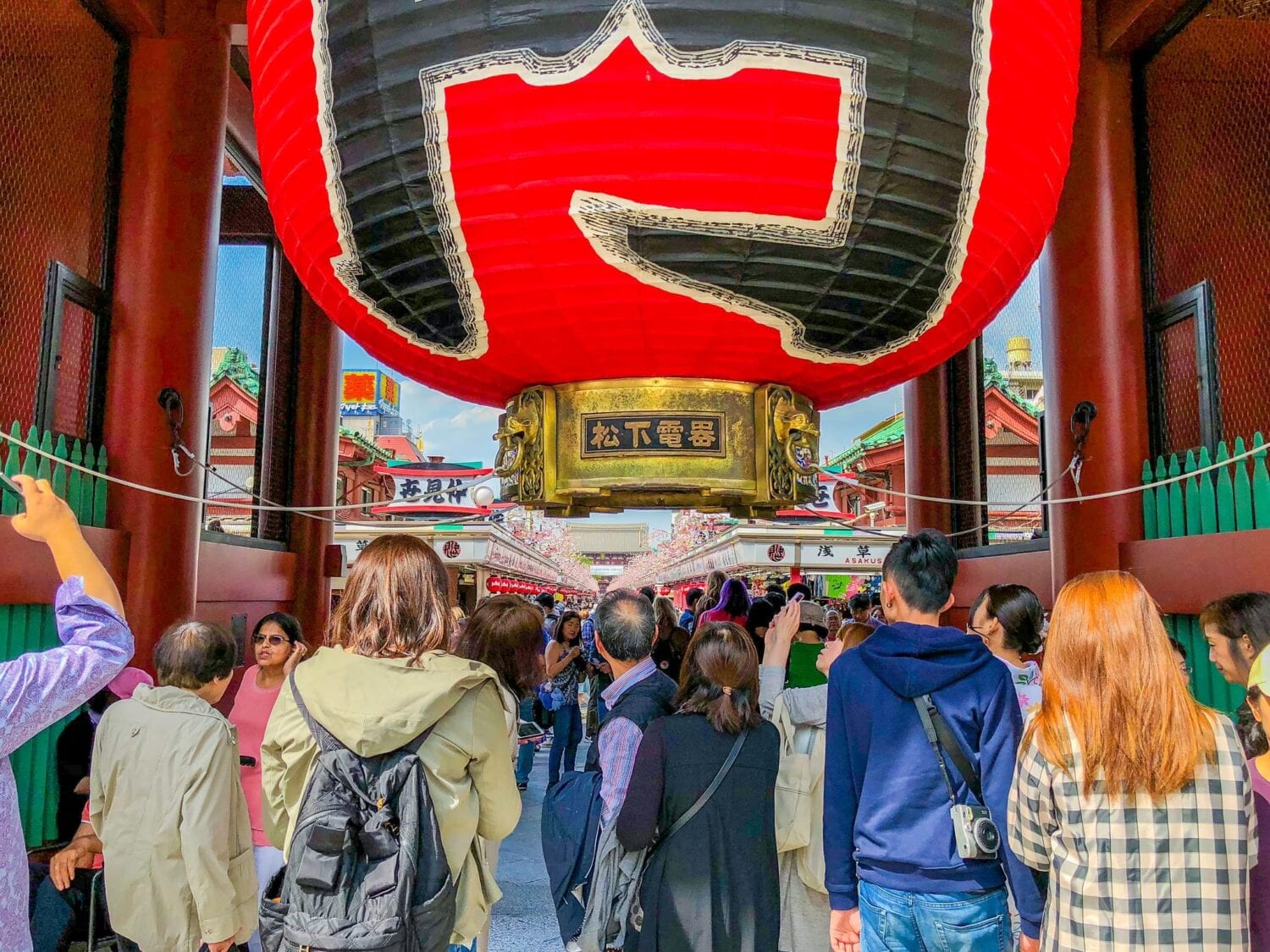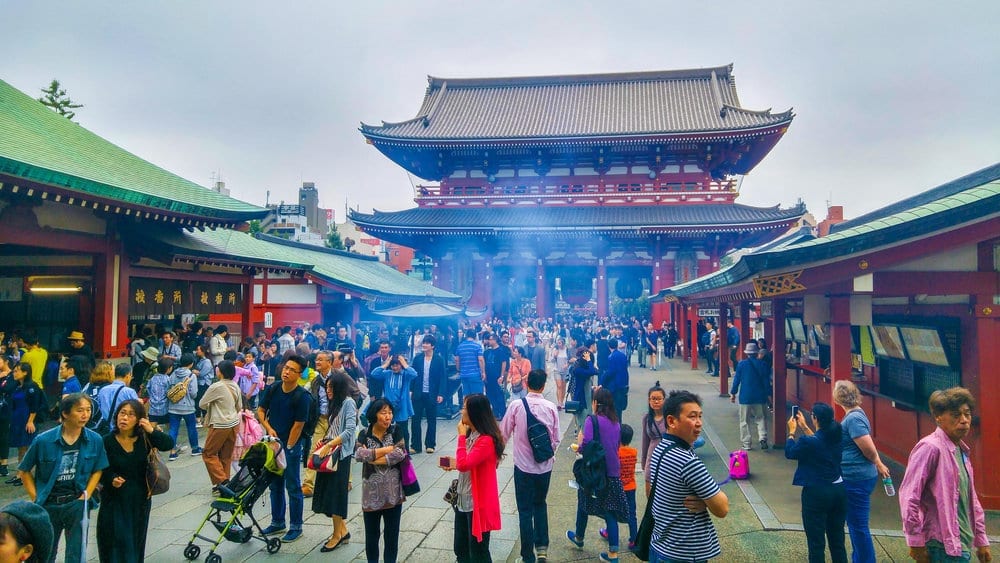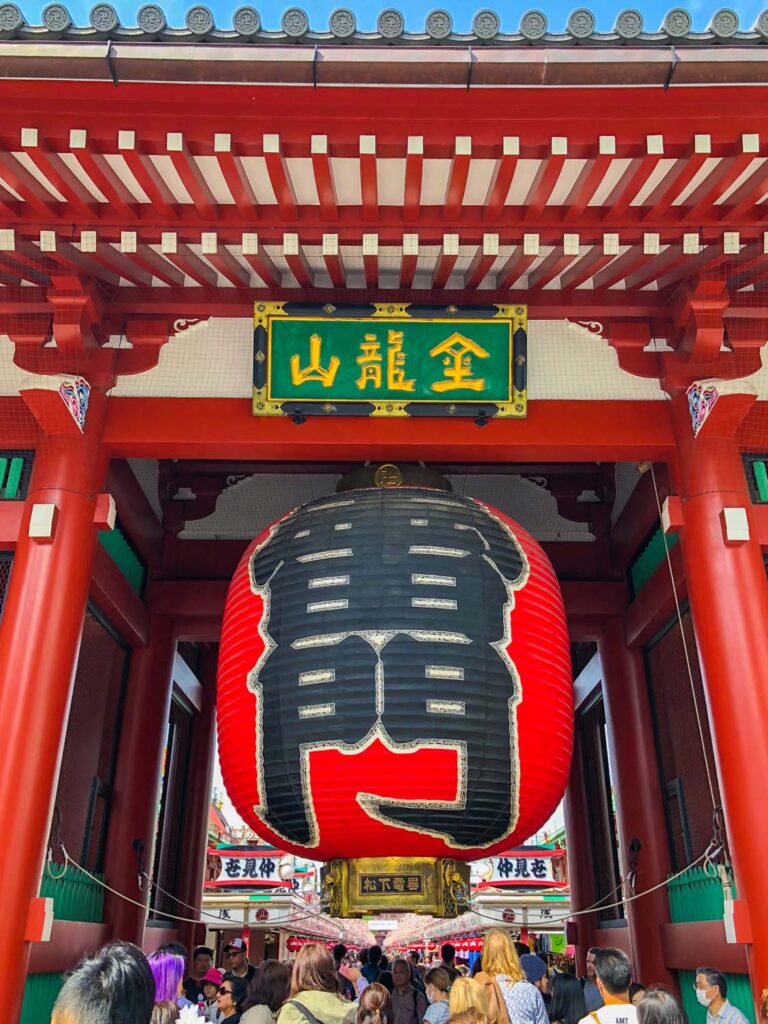

When you think of visiting Japan, no doubt one of the first things you’ll imagine is walking into an ancient temple painted bright vermillion, the smells of incense wafting the air. One of the most iconic of these temples is Sensoji in Asakusa, Tokyo. Perhaps the most visited temple in Tokyo, Sensoji is also the oldest temple in the city, with over half millennia of stories to tell.




Sensoji is a Buddhist temple which was first built in 645 AD. In the early 1600s, the Tokugawa shogun created the city of Edo. Edo’s defences were the weakest near its northeast and southwest edges or, as they called them, the “demon gates.” Tokugawa needed all the help he could get to help defend them. For this reason, he created two temples in each location to help call on the Buddha to protect his land. Sensoji was the protector of the northeast district, and the Zojoji temple was built in the southeast to ensure full protection around Tokyo.
There are various ways of travelling to Sensoji temple. Sensoji is only minutes from Asakusa Station, served by various railways making it a quick and easy journey. Take either the Ginza Subway Line, Hanzomon Line or Asakusa Line towards Asakusa station.
Most people enter through the Kaminarimon Gate. This is the traditional entrance to the temple, but I would you enter through the Northwest gate. This entry is much less crowded and allows a more peaceful entrance to the temple. Then you can explore the Kaminarimon gate area afterwards. This passage feels almost like a secret. There is no right or wrong way to experience this temple, and although this might be considered a bit backward, it’s worth trying this alternate route.
Along the passageway to the temple, there is a huge white sign with bright red kanji letters printed on it, welcoming you to the Sensoji temple. Along the stone pathway are groups of red lanterns. Each of the lanterns along the ground lights up at night, providing a gorgeous glowing pathway for visiting coming in the evening.
From a distance, the bright red roof of the temple pops out above the trees. The golden filigree sparkled, even without the sun shining. Temples in Japan are all made of wood, as wood was used more than stone because of the earthquakes, which would so often rock the country. Intricate carvings and decorations are embedded into the timber construction.
As you walk around the grounds of the temple, you’ll spot dozens of women dressed in gorgeous kimonos. They were both tourists and locals alike. Kimonos are a very formal pieces of attire, so even people who own them never really get a chance to wear them often. Visiting a sacred temple is an opportunity to wear such attire, so people take the time to dress up. Even if you don’t own a kimono, as they are incredibly expensive, there are lots of shops around that rent them out so you can explore in style. As you wander around the temple, these beautifully dressed women pop up like brightly coloured flowers coming into bloom.
Surrounding the temple are several koi ponds filled with bright orange and black spotted fish. Koi fish symbolize good fortune and are known to be very lucky. They give the observer strength of purpose. For this reason, they are often found all around Buddhist temples.
Make your way to the ablution fountain. There you’ll see a huge dragon sculpted atop a bronze pagoda-shaped altar. Take a moment here to purify yourself and listen to the water trickling below your feet. This area is one of the calmest parts of the grounds as it’s not the main attraction and, therefore, not overrun with tourists. Spend a few minutes here basking in the peace and tranquillity of the landscape around you.
Before entering the shrine, it is customary to cleanse yourself at the chozuya. If you’ve never done this before it is an interesting custom which is worth trying for yourself to give yourself over to the traditional experience. To perform this cleaning follow the steps below:
As you enter the temple, you ascend long concrete stairs. Although the temple doesn’t seem very high, walking up this long set of stairs makes you feel like you’re stepping away from the mortal plain and entering another place altogether.
Inside the temple, you’ll first notice the enormous golden statue, lights and flowers behind a massive glass wall. This is the central area for prayer, where only priests are allowed. One of the reasons that Sensoji is so popular is because it is known to contain a very mythical statue. As legend tells, two brothers were fishing in a river during the Edo period. They caught a golden statue of the Buddhist deity Kannon in their nets. The brothers threw it back in the water, but every time they put their lines back in the water, they would catch the statue again. They brought the statue to their village chief, who built a temple in its honour.
People came from everywhere to worship the incredible statue. Although you can’t see the icon today, some say it’s buried under the temple for protection; people still come from all over to worship here. Keep your eyes peeled for Asakusa’s crest while exploring the city. It’s a crest with three nets symbolizing the nets used to catch the golden statue.
The ceiling of the temple portrays various celestial scenes of Buddhism. A nymph is pictured swirling among cherry blossoms, and a dragon curls its tail against a watercoloured sky. Perfectly framed against that bright red wooden ceiling.
Two shops on either side of the entrance stairs sell omamori amulets, scrolls, incense, books about the temple and omikuji fortunes. Omikujis are random fortunes written on paper held in labelled drawers. To receive your fortune, place a few yen into a metal box and pick out a small wooden stick from an adjacent container. The kanji characters on the wooden stick will lead you to the box where you’ll find your fortune.
Luckily, since this is a big tourist site, the fortunes have small English translations and Japanese kanji. We received a “last and small fortune.” Not the greatest results but not a dreaded “worst fortune.” If you receive a negative fortune, fold the piece of paper into a thin strip and tie it up on the thin string outside the temple – you’ll see hundreds of other bad fortunes tied up there as well. By tieing your fortune up here, you leave this bad omen behind.
The best souvenir from the shrine is the goshuincho calligraphy. A goshuincho is an “honourable stamp/seal book.” You can buy a blank notebook before you arrive or when you get to any temple. Each temple has a different design, so pick your favourite. Then, at every temple, you can pay ¥500 to have your book handed over to a local priest who will stamp it with the temple’s seal and write the temple’s name and date in beautiful calligraphy. Collecting these becomes a little tradition for yourself at every place you visit. It’s an inexpensive and meaningful souvenir, as the money given goes towards the maintenance of the temple.
Exit the temple down the centre staircase, which leads you to the main courtyard. This is a great space, a great spot to grab a photo of the entire complex. I like being able to take the photo after visiting the interior as you don’t feel as rushed to get inside and can instead take your time to study the exterior surroundings.
People are usually packed around a large copper incense burner in the centre of the square. Many visitors waft the smoke toward any part of their body that aches, as legend has it that the incense from the temple will help cure what ails you. You’ll find incense for sale throughout the market and inside any of the temple shops. Feel free to purchase some and light it inside this vast burner.
Head over to above the striking Goju-no-to, the five-storied pagoda. This pagoda is from the 10th century and is one of the last of its kind. Inside, it contains thousands of memorial tablets and Japanese gravestones, and as such, it is closed to visitors. Every five stories represent elements of the Buddhist universe; sky, wind, fire, water and earth.
South of the temple is two enormous gates. The first gate you’ll pass as you continue south is the Hozomon Gate. Despite being called a “gate,” it looks more like a building. The Hōzōmon was first built in 942 AD, it was destroyed by fire and war many times over the years, and the current gate is the result of reconstruction from 1945.
Inside the gate are three giant lanterns hanging beneath three passageways. The largest of the lanterns is a red chōchin which weighs over 400 kg. Besides the large chōchin are two smaller copper tōrō. Tōrō, in English, literally translates to “light basket.” These lanterns are considered an offering to Buddha and, as such, are often seen as you enter a Buddhist temple.
Flanking each side of the gate are two Nio statues. They are protectors, ready to defend their temple should the need arise. The designs of the current figures were made in the 1960s and modelled after famous sumo wrestlers. They each wear jumbo-sized waraji straw sandals, and each year, the townsfolk gather to help create new pairs after the old ones become too weather-worn.
Head away from the temple, down Nakamise shopping street. The street is over 100 years old and 250 meters long. The name means “inside street,” as the road is technically located within the temple grounds. These days the shops mainly sell different types of souvenirs. Although you might seem dubious about buying anything here since it looks like a tourist trap, I found that the prices here were more than reasonable! These shops have offered traditional Japanese handicrafts for over a hundred years. So don’t be afraid to pick something up! I’m not saying you’ll get the best deal, but by no means are you paying top dollar.
This is another one of the reasons I like this guide since it allows you to shop on your way out, so you’re not carrying shopping bags with you inside the temple. Besides typical Japanese souvenirs such as yukatas and folding fans are traditional local snacks from the Asakusa area.
One of my favourite parts of Nakamise Street is the food. Sample various traditional treats like curry buns, sakura mochi, Amezaiku candy, Dango and more. Check out my street food guide to Asakusa here for a full list of the things you NEED to try when visiting.
At the end of Nakamise street is the Kaminarimon, or “Thunder Gate.” This is the main entrance for most people visiting, but I find it makes for the perfect ending. The original Kaminarimon was built over 1000 years ago. Under the large, ornate roof stands two bronze statues. These represent the deities Fujin-same and Raijin-same, the god of wind, thunder, and lightning. In the centre of the gate hangs a GIANT red lantern with the kanji letters for “thunder gate” written on it. Above the red lamp is a green plaque that reads “Golden Dragon Mountain,” the original name for Sensoji. The contrast between the teal wood pickets and the vermillion red structure is striking.
You can’t help but shudder under its imposing nature, and it makes you understand why the shogun designed it this way. This was his place of protection. Even without being surrounded by an army or soldiers, the structure spoke volumes about the strength and power of the empire it was under.
Visiting Sensoji Shrine is much more than just one little building. It’s an entire complex full of incredible pieces of architecture from Japan’s past and culinary treats to fuel your body as you explore!
Perched dramatically on a limestone hill overlooking the lush Tipperary countryside, the Rock of Cashel…
Affectionately known as the "Garden of Ireland," Wicklow County is one of the most breathtaking…
Paris has long been a magnet for writers for hundreds of years, with iconic figures…
Paris transforms into a magical wonderland from November to January, bursting with festive charm and…
French cuisine is one of the coziest delights to savour in winter. With its hearty…
During the festive season, Paris becomes a sparkling holiday dream, with twinkling fairy lights cascading…
This website uses cookies.